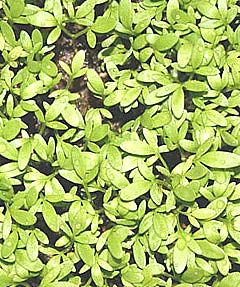How to grow Mustard and Cress for salads
VEGETABLE GUIDES
GARDEN TIP
There is an old saying: One year's seeds - seven year's of weeds.
Don't allow weed seedlings to to develop and set seed or you will be storing up weeding problems for coming years.
Keep on top of your weeding - check flower borders and the vegetable garden at least once a week during spring and summer and pull up any weeds as soon as you see them!
Regularly hoe any areas of bare soil to prevent weed seedlings growing.
A thick mulch of compost or bark can also help to prevent weeds.
SOCIETIES
GARDEN TIPS
It is better to water heavily oncea week ather than a little bit every day - light sprinklings of water don't penetrate into the soil deeply enough to do much good.
Tie a broom handle to your hose pipe to help you to water hanging baskets leaving about 30 centimeters free at the end to hang down naturally.
MUSTARD AND CRESS - A TASTY SALAD CROP
 Mustard and cress
sprouts are a classic, quick to grow combination, for a tasty salad with
a spicy, peppery flavour.
Mustard and cress
sprouts are a classic, quick to grow combination, for a tasty salad with
a spicy, peppery flavour.
White mustard is the kind of mustard grown for salads; cress can be either the curled or plain varieties. The most common variety of cress to grow is Lepidium Sativum
There is also another type of cress called American or land cress - a perennial that tastes like watercress.
Although these salads are usually referred to as mustard and cress, it is more usual to actually grow rapeseed and cress, because rapeseed has more flavour.
PROBLEMS WITH GROWING MUSTARD AND CRESS
The main difficulty in growing mustard and cress is that the seedlings tend to bring up their seed cases and particles of soil with them. These Particles of soil cling to the stems and leaves and make the end product gritty.
To avoid grittiness it is best to grow these on damp sacking material which can be laid on boxes in the greenhouse or on the soil outside.
Alternatively, sow the seeds on damp fine peat.
If you are going to use soil, then water the bed with boiling water before sowing to kill the fungus spores of damping off disease.
You should find that this fungus trouble does not appear when sacking or hessian material is used.

USING SACKING OR HESSIAN
Cut a piece of hessian, the size of the inside of the tray, and lay this over the seeds.
Keep the hessian damp until the seeds are through. The Hessian will hold the seed cases and soil in place while allowing the shoots to push through.
When the seedlings are about 2-3 cm in height , carefully remove the Hessian and leave them to grow on.
GROWING MUSTARD AND CRESS ON KITCHEN PAPER
Mustard and cress can also be grown on moist absorbent paper - such as kitchen paper or blotting paper.
This method can be used to grow mustard and cress on a kitchen windowsill for a convenient source of fresh salad.
SOWING MUSTARD AND CRESS
In order for the two crops to mature at the same time, sow the mustard or rape seeds three days after the cress.
These will take from ten to fourteen days to mature.
To get good results for even and speedy germination, make sure the freshly sown seed is kept in the dark.
You can do this by using more damp sacking material or just covering over with boxes.
Keep in the dark until the seed has germinated.
As a rule make summer sowings in the open, spring sowings in a frame and winter sowings in the greenhouse.

HARVESTING MUSTARD AND CRESS
Cut the mustard and cress, as and when they are needed - but while still young and tender.
If grown on soil, cut with a pair of scissors and wash well before eating.
AMERICAN LAND CRESS
American land cress can be grown in ordinary garden soil and prefers a north-facing or semi-shaded position where the soil remains moist.
This variety of cress needs plenty of water and should never be allowed to dry out completely.
They are quite hardy plants and take from 8-10 weeks to mature from seed.
Always use fresh seeds.
